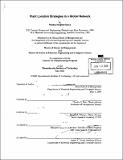| dc.contributor.advisor | Charles H. Fine and Daniel E. Whitney. | en_US |
| dc.contributor.author | Basca, Michael Stephen, 1972- | en_US |
| dc.contributor.other | Massachusetts Institute of Technology. Dept. of Electrical Engineering and Computer Science. | en_US |
| dc.date.accessioned | 2005-08-22T23:07:47Z | |
| dc.date.available | 2005-08-22T23:07:47Z | |
| dc.date.copyright | 2000 | en_US |
| dc.date.issued | 2000 | en_US |
| dc.identifier.uri | http://hdl.handle.net/1721.1/9152 | |
| dc.description | Thesis (S.M.)--Massachusetts Institute of Technology, Sloan School of Management; and, (S.M.)--Massachusetts Institute of Technology, Dept. of Electrical Engineering and Computer Science, 2000. | en_US |
| dc.description | Includes bibliographical references (p. 56-57). | en_US |
| dc.description.abstract | Companies currently utilize a number of different approaches to making decisions around where to locate factories. This thesis analyzes the specific challenges faced by Polaroid Corporation in making site location decisions for its instant film assembly operation. The methodology used to arrive at this specific set of recommendations, however, can be extended for use by any company. Three main approaches are taken for determining the optimal site locations: The first approach involves the development of a simplified cost model. This exposes the current cost competitiveness of the sites under consideration. The sites are also evaluated under a variety of scenarios to determine their performance under future variance in exchange rates. The second analytical method employed is a characteristic matrix. This approach facilitates the inclusion of qualitative factors which may be critical to the performance of the factory. All four of Polaroid's film assembly factories were visited to observe the unique capabilities of the sites. A graphical representation of the sites' proficiency for development activities, low cost manufacturing, and flexible manufacturing is developed. In the final technique, the strategic trends and decisions of the instant film business are examined. The company is in the midst of a radical shift in product strategy. New products are being positioned on the basis of fashion more than performance. This shift has important implications for the demands placed on the manufacturing organization. An integrated set of recommendations is synthesized from the results of the three separate approaches. A shift in plant focus from product and market focus to life cycle focus is suggested. The sites with the capabilities and cost structure for the different life cycle roles are identified. | en_US |
| dc.description.statementofresponsibility | by Michael Stephen Basca. | en_US |
| dc.format.extent | 57 p. | en_US |
| dc.format.extent | 5255623 bytes | |
| dc.format.extent | 5255381 bytes | |
| dc.format.mimetype | application/pdf | |
| dc.format.mimetype | application/pdf | |
| dc.language.iso | eng | en_US |
| dc.publisher | Massachusetts Institute of Technology | en_US |
| dc.rights | M.I.T. theses are protected by copyright. They may be viewed from this source for any purpose, but reproduction or distribution in any format is prohibited without written permission. See provided URL for inquiries about permission. | en_US |
| dc.rights.uri | http://dspace.mit.edu/handle/1721.1/7582 | |
| dc.subject | Sloan School of Management. | en_US |
| dc.subject | Electrical Engineering and Computer Science. | en_US |
| dc.title | Plant location strategies in a global network | en_US |
| dc.type | Thesis | en_US |
| dc.description.degree | S.M. | en_US |
| dc.contributor.department | Massachusetts Institute of Technology. Department of Electrical Engineering and Computer Science | |
| dc.contributor.department | Sloan School of Management | |
| dc.identifier.oclc | 45258095 | en_US |
